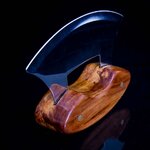budnder
Member
Made this for my daughter as a Christmas gift. Blade purchased from Jantz Supply for $8. Brass rod from Menards was a couple of bucks. A storm earlier this year had previously donated a Maple tree branch for the handle.
I like the concept behind the Ulu (weight on top of the cutting blade) - now I want one for myself.
If you haven't seen one of these before the picture might be confusing - in the picture, the knife is upside down, sitting on the handle. To use it, you hold the wood handle, with the blade pointing down and "chop/roll" to cut something like a vegatable. You can also use it as a scraper.
I bought a leather cover off of Amazon for the blade that you'd keep on it when it's stored in a drawer.
I like the concept behind the Ulu (weight on top of the cutting blade) - now I want one for myself.
If you haven't seen one of these before the picture might be confusing - in the picture, the knife is upside down, sitting on the handle. To use it, you hold the wood handle, with the blade pointing down and "chop/roll" to cut something like a vegatable. You can also use it as a scraper.
I bought a leather cover off of Amazon for the blade that you'd keep on it when it's stored in a drawer.
Attachments
Last edited:


